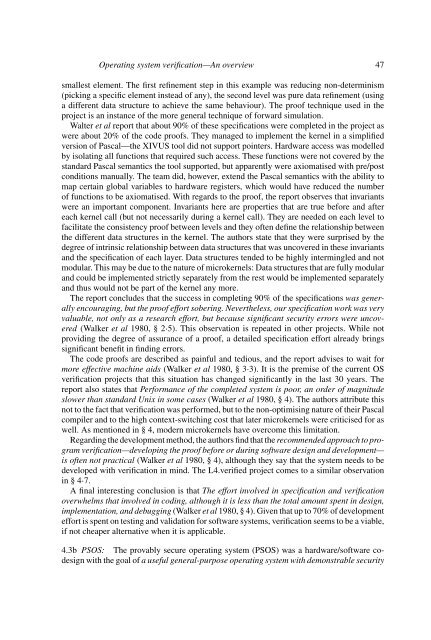Operating system verificationâAn overview
Operating system verificationâAn overview
Operating system verificationâAn overview
Create successful ePaper yourself
Turn your PDF publications into a flip-book with our unique Google optimized e-Paper software.
<strong>Operating</strong> <strong>system</strong> verification—An <strong>overview</strong> 47<br />
smallest element. The first refinement step in this example was reducing non-determinism<br />
(picking a specific element instead of any), the second level was pure data refinement (using<br />
a different data structure to achieve the same behaviour). The proof technique used in the<br />
project is an instance of the more general technique of forward simulation.<br />
Walter et al report that about 90% of these specifications were completed in the project as<br />
were about 20% of the code proofs. They managed to implement the kernel in a simplified<br />
version of Pascal—the XIVUS tool did not support pointers. Hardware access was modelled<br />
by isolating all functions that required such access. These functions were not covered by the<br />
standard Pascal semantics the tool supported, but apparently were axiomatised with pre/post<br />
conditions manually. The team did, however, extend the Pascal semantics with the ability to<br />
map certain global variables to hardware registers, which would have reduced the number<br />
of functions to be axiomatised. With regards to the proof, the report observes that invariants<br />
were an important component. Invariants here are properties that are true before and after<br />
each kernel call (but not necessarily during a kernel call). They are needed on each level to<br />
facilitate the consistency proof between levels and they often define the relationship between<br />
the different data structures in the kernel. The authors state that they were surprised by the<br />
degree of intrinsic relationship between data structures that was uncovered in these invariants<br />
and the specification of each layer. Data structures tended to be highly intermingled and not<br />
modular. This may be due to the nature of microkernels: Data structures that are fully modular<br />
and could be implemented strictly separately from the rest would be implemented separately<br />
and thus would not be part of the kernel any more.<br />
The report concludes that the success in completing 90% of the specifications was generally<br />
encouraging, but the proof effort sobering. Nevertheless, our specification work was very<br />
valuable, not only as a research effort, but because significant security errors were uncovered<br />
(Walker et al 1980, § 2·5). This observation is repeated in other projects. While not<br />
providing the degree of assurance of a proof, a detailed specification effort already brings<br />
significant benefit in finding errors.<br />
The code proofs are described as painful and tedious, and the report advises to wait for<br />
more effective machine aids (Walker et al 1980, § 3·3). It is the premise of the current OS<br />
verification projects that this situation has changed significantly in the last 30 years. The<br />
report also states that Performance of the completed <strong>system</strong> is poor, an order of magnitude<br />
slower than standard Unix in some cases (Walker et al 1980, § 4). The authors attribute this<br />
not to the fact that verification was performed, but to the non-optimising nature of their Pascal<br />
compiler and to the high context-switching cost that later microkernels were criticised for as<br />
well. As mentioned in § 4, modern microkernels have overcome this limitation.<br />
Regarding the development method, the authors find that the recommended approach to program<br />
verification—developing the proof before or during software design and development—<br />
is often not practical (Walker et al 1980, § 4), although they say that the <strong>system</strong> needs to be<br />
developed with verification in mind. The L4.verified project comes to a similar observation<br />
in§4·7.<br />
A final interesting conclusion is that The effort involved in specification and verification<br />
overwhelms that involved in coding, although it is less than the total amount spent in design,<br />
implementation, and debugging (Walker et al 1980, § 4). Given that up to 70% of development<br />
effort is spent on testing and validation for software <strong>system</strong>s, verification seems to be a viable,<br />
if not cheaper alternative when it is applicable.<br />
4.3b PSOS: The provably secure operating <strong>system</strong> (PSOS) was a hardware/software codesign<br />
with the goal of a useful general-purpose operating <strong>system</strong> with demonstrable security
















